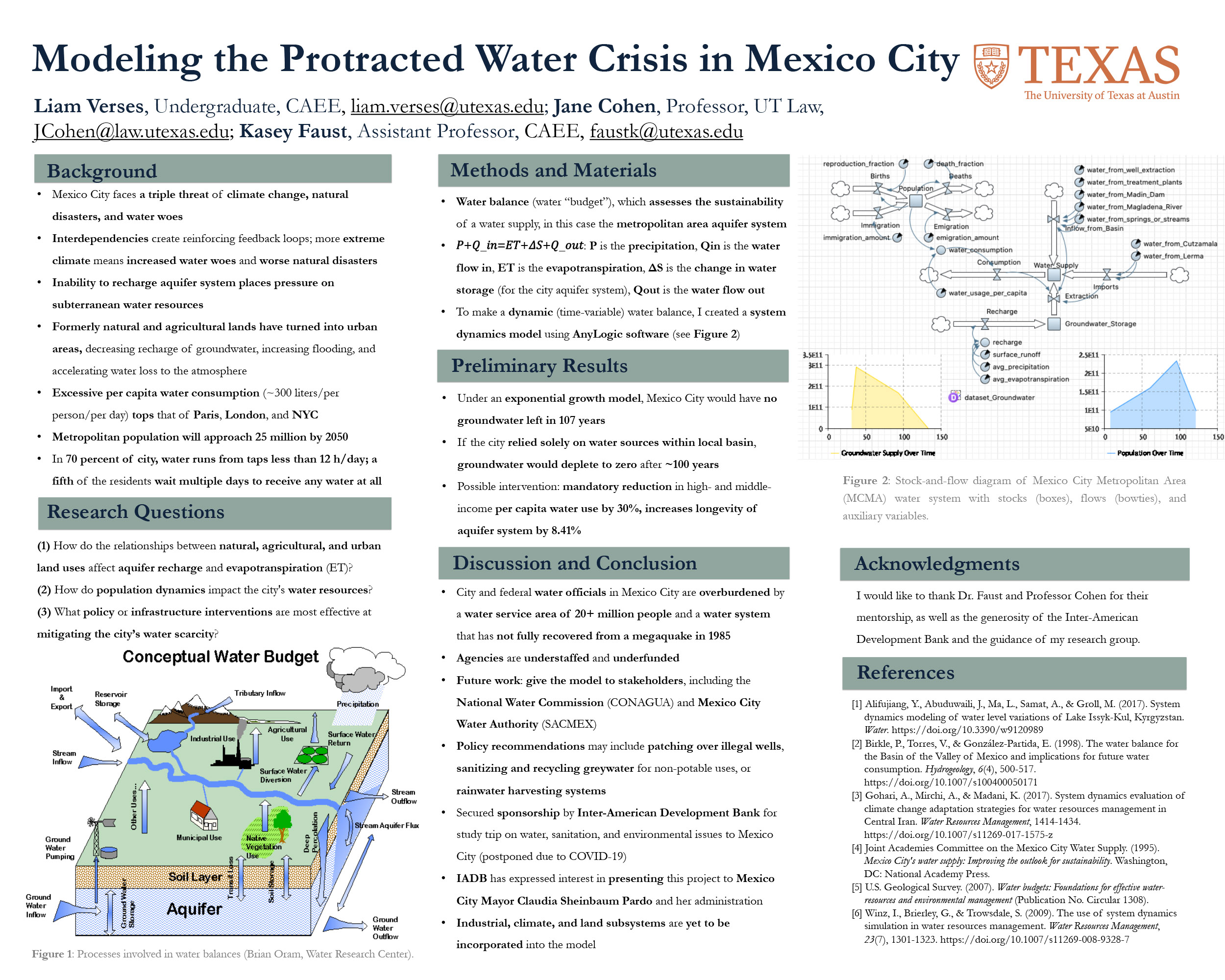Verses, Liam M, Cohen, Jane M, & Faust, Kasey M
A fifth of Mexico City residents lack access to reliable water service, and some parts of the city are subsiding at 9 inches per year as the city’s subterranean aquifer system dwindles. This water crisis involves issues of water supply, water demand, climate dynamics, population change, land use, and industrial growth. The inability to recharge the aquifers below the city’s surface coupled with deforestation and urbanization have simultaneously decreased water availability and increased flood risk. Mexico City faces a triple threat of natural disasters, climate change, and water scarcity, all of which are expected to worsen during this century. This project seeks to identify policy and infrastructure interventions to alleviate water stresses. This will reveal leverage points in the water system that will bolster sustainability and resilience. Specific research questions include: How do the relationships between natural, agricultural, and urban land uses affect aquifer recharge and evapotranspiration (ET)? How do population and climate dynamics exert pressure on the city’s water resources? How does industrial growth impact water availability for domestic and commercial uses? To accomplish this, system dynamics is used to explore the local water balance, which assesses how a natural or human-induced change in part of the hydrologic cycle may ripple throughout. System dynamics allows for better qualitative and quantitative understanding by considering nonlinear, circular, and interdependent relationships in this complex system. Stakeholders in Mexico, including the National Water Commission and Mexico City Water Authority, will hopefully be engaged. Ultimately, this model will be turned over to stakeholders in Mexico for their use. Final recommendations may include patching over illegal wells, sanitizing and recycling greywater for non-potable uses, and rainwater harvesting.

Comments
Excellent work, Liam! And your poster does a great job of communicating both the nature and complexity of the problem and possible avenues to address it. I love that you included information about future dissemination of the work, and that you’re addressing it to the audiences that matter most. Congratulations! —Jeanette Herman
Thank you very much, Dr. Herman! —Liam Verses
I found your background section very striking — it’s very effective at setting the scene for why Mexico City is facing this challenge (and others). —Rob Reichle
Hi Dr. Reichle, thank you! The water crisis has been dubbed a “wicked problem,” so it’s hard to pare down to just a few bullet points when it comes to the background. But I’m glad that you found the points included effective! —Liam Verses
What a fascinating topic! The explanations and diagrams were all very clear and concise. A few questions: How does one determine the “Qin” variable and what sources would it come from (why is it separated from precipitation)? Apart from the possible intervention, are there any current actions/responses to this issue that are already taking effect, or is your model based on a “no actions taken” assumption? Overall, great work! —Evana Wang
Hi Evana, Thanks for the comment! So, in this particular case, the Qin variable is actually zero. It typically represents the groundwater flow beneath the surface into the aquifer, which makes it separate from the precipitation term. Qin (and Qout) would only be active if there were active movement of water beneath the surface from other basins in the region. The thing about Mexico City is that it lies in a naturally-endorheic basin, which means it’s essentially a giant bowl. Thus there is no other source of groundwater that can contribute (or take from) the aquifer. Regarding your second question, my model is based on a “business as usual” assumption over the model time. Certainly, there has been some action by the government/private sector on this crisis, such as the massive deployment of rainwater harvesting systems to reduce dependence on public water. But the situation hasn’t improved (and in fact has worsened) since the 1990s, when the crisis was described as dire. Hopefully, I’ll be able to model out many more interventions and factor into the model other courses of action currently being discussed, such as pumping recycled wastewater into the aquifer system to replenish it. Thank you! —Liam Verses

